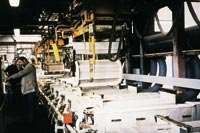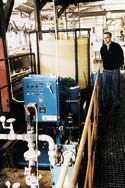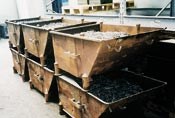NKT Improves Plating with Filtration
This Danish plater installed a permanent-media filtration system on its second automated barrel plating line...
#pollutioncontrol
When NKT Wire Works of Middelfart, Denmark, purchased its second automatic barrel plating line from CIE of Italy, it did not expect the results to look like gold, or even brass. However, with a solution that was filtered as clear as apple juice, its fasteners took on that appearance.
Actually, the solution was acid zinc-iron alloy in a 2,100-U.S. gal tank with 11-barrel stations used to plate wood screws and automatic single-set nails. The company also uses other plating solutions to produce wire mesh and screens used in the separator stage of mining operations.
Featured Content
NKT’s first automatic plating machine was equipped with a movable belt-type paper filter. The filter had a pressurized area that clamped a small portion of paper media that retained the iron, but as the media loaded, the flow was reduced. The paper was manually indexed daily to be clamped into a new pressurized platen bed. Thus, the flow was never at its maximum point to achieve good solids removal, and the solution was always brown and murky, creating a dull deposit.
When a second automatic plating machine was considered, NKT’s chemical supplier, Ytema of Sweden also told NKT about an automatic multimedia filter that it had seen in operation in the United Kingdom. The filter removed iron continuously from an acid zinc solution without manual attention. It featured a computerized control panel that sensed both pump pressure and flow rate to actuate a backwashing procedure that operated unattended.
NKT liked the concept of a separate filter independent of the plating machine and ordered the TITAN filter, manufactured by Serfilco, Ltd. It was installed in January 1998. To date the system has operated with daily backwashing and without filter media replacement or disposal costs.
The acid zinc solution was not murky as was the case in the first automatic machine, but impressively clear, which acknowledges that not just some, but actually all the precipitated iron was removed almost as fast as it was generated. Moreover, the daily backwashing kept the multimedia filter clean so it could maintain optimum filtration.
The significant difference between the filtration methods was the high flow rate due to the automatic backwashing cycle. During backwashing, the media is first purged with air to send the plating solution back to the plating tank. Then, with automatic valving, water from a clean source is directed into the filter discharge port. The force and velocity of the water into the filter media dislodges the accumulated iron particles, sending them out of the filter chamber into a collecting tank for metering into the company’s waste treatment system. The iron particles are then disposed of with other neutralized hydroxide solids.
It was thought that an occasional leaching with a solution of hydrochloric acid might be necessary, but after more than a year of continuous operation, the filter media is still free of any residual iron and performing at its designed flow rate.
The filter system is designed for two turnovers per hour, which means the total volume of liquid in the plating tank passes through the filter at least twice each hour. Of further benefit to NKT is the possibility of operating 24 hours a day, 7 days a week. The totally automatic system requires no labor, and there will be no time lost for shutdown and maintenance.
The pump on the system features an enclosed highefficiency impeller capable of discharge pressures up to 45 psi, driven by a 3-hp motor. The pump seal is water lubricated to prevent abrasive wear or the introduction of air, so a long seal life can be expected.
The plating achieved in this automatic barrel line is consistently high quality and uniform in coverage, averaging 5 microns. The 1-meter barrels hold between 132 and 176 lb of product. The color is bright, and most importantly, customers are provided with product that meets their most stringent requirements.
NKT packages 17,600 lb of wire goods daily. Without consistently reliable filtration, the cost of rejects in terms of labor, storage, handling and rework could reach unacceptable levels. Perhaps the most telling fact about this application is the low profile the filtration system has maintained since its installation and especially during the 6-month tenure of the new manager. It has not developed maintenance troubles or consumable costs.
To learn more visit Serfilco, Ltd., Service Filtration Corp..
RELATED CONTENT
-
Plating Q&A: Can you color stainless steel?
Our expert, Art Kushner, says yes, you can color stainless steel, but it is not a process that is typically performed in a plating shop. Read more about his answer.
-
An Overview of Electroless Nickel Plating
By definition, electroless plating is metal deposition by a controlled chemical reaction.
-
Aluminum Anodizing
Types of anodizing, processes, equipment selection and tank construction.





















